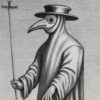Tenth Cranial Nerve Lesions
The vagus nerve (cranial nerve X) carries motor, sensory, and autonomic fibres, forming a major part of the parasympathetic nervous supply of the body.
Isolated vagus nerve lesions are rare. They are typically seen in combination with lesions of other caudal brainstem cranial nerves.
Anatomy
Course and Nuclei
The vagus nerve has the most extensive distribution of all cranial nerves, extending from the medulla through the neck and thorax into the abdomen.
Brainstem nuclei (medulla oblongata):
| Nucleus | Function |
|---|---|
| Nucleus ambiguus (lateral medulla) | Somatic efferents for CN IX, X, XI |
| Nucleus solitarius (lateral medulla) | Sensory relay nucleus for CN VII, IX, X |
| Dorsal vagal nucleus (medial medulla) | Parasympathetic fibres for CN X |
Intracranial and Cervical Course
- Emerges from the lateral medulla (posterior olivary sulcus), between CN IX and XI.
- Exits the skull via the jugular foramen (with CN IX, XI, IJV, and inferior petrosal sinus).
- Enlarged by two sensory ganglia: superior (within foramen) and inferior (just below it).
- Joined by the cranial root of CN XI below the inferior ganglion.
In the neck:
- Descends within the carotid sheath, between the IJV and carotid arteries.
- At the root of the neck: anterior to the subclavian artery, medial to the phrenic nerve.
Recurrent Laryngeal Nerves
- Right: Loops around the subclavian artery.
- Left: Loops under the aortic arch near the ligamentum arteriosum.
- Both ascend in the tracheo-oesophageal groove to supply the larynx.
Thoracic and Abdominal Course
- Both nerves pass posterior to lung roots and contribute to the pulmonary plexus and cardiac branches.
- Right vagus: posterior to oesophagus → oesophageal plexus → enters abdomen behind oesophagus.
- Left vagus: anterior to oesophagus → oesophageal plexus → enters abdomen anterior to oesophagus.
Abdominal branches supply parasympathetics to:
- Liver
- Pancreas
- GIT up to the splenic flexure (beyond which sacral nerves take over)
Major Branches and Innervation
| Region | Branches | Function |
|---|---|---|
| Jugular foramen | Meningeal, Auricular | Sensory to dura (posterior fossa), ear |
| Neck | Pharyngeal, Superior laryngeal (external + internal), Cardiac, Right recurrent laryngeal | Motor: all pharynx (except stylopharyngeus), all soft palate (except tensor veli palatini), cricothyroid; Sensory above vocal cords |
| Thorax | Left recurrent laryngeal, Cardiac, Pulmonary, Oesophageal | Larynx (except cricothyroid), afferents from aortic arch, lungs, oesophagus |
| Abdomen | Gastric, Celiac plexus, Hepatic | Parasympathetic supply to GIT (up to splenic flexure), pancreas, liver |
Pathology
Lesions are rarely isolated and commonly involve other lower cranial nerves.
Central Causes
- Vascular: Lateral medullary infarction (e.g. vertebral or PICA)
- Tumour
- Motor neurone disease
- Syringobulbia
Peripheral Causes (Posterior Fossa)
- Aneurysm
- Tumour
- Guillain-Barré syndrome
- Trauma
Clinical Assessment
1. Inspection
- Observe soft palate position for asymmetry.
2. Movement
- Gag reflex: Ask patient to say “ahh” and observe uvula deviation (toward normal side).
- CN IX: sensory limb; CN X: motor limb.
- Absent contraction with intact sensation → CN X palsy.
- Voice: Assess for dysarthria (recurrent laryngeal nerve).
- Cough: Weak or “bovine” cough with bilateral recurrent laryngeal nerve palsy.
- Swallowing: Often impaired in CN X lesions.
3. Bulbar Syndromes
- Pseudobulbar palsy: Bilateral UMN lesions (CN IX, X, XII)
- Bulbar palsy: Bilateral LMN lesions (CN IX, X, XII)
Investigations
Blood Tests
- FBC
- U&Es / Glucose
- CRP
- ESR
Imaging
- CT / CTA: To exclude mass lesion or aneurysm
- MRI: To visualise brainstem lesions or the nerve itself
Management
- Treatment depends on the underlying cause of the lesion.
References
Publications
- Brazis PW, Masdeu JC, Biller J. Localization in Clinical Neurology. 8e 2021
- Fuller G. Neurological Examination Made Easy. 6e 2019
- O’Brien M. Aids to the Examination of the Peripheral Nervous System. 6e 2023
FOAMed
- Cadopgan M. Bezold–Jarisch reflex. LITFL
- Nickson C. Bulbar and pseudobulbar palsy. LITFL
- Nickson C. Pseudobulbar and bulbar palsies. LITFL
- Coni R. Neuro 101: Cranial Nerves. LITFL
- Nickson C. The Brainstem Rules of Four. LITFL
- Ercleve T. The rule of 4 of the brainstem. LITFL
- Nickson C. Cranial nerve lesions DDx. LITFL
Fellowship Notes
MBBS DDU (Emergency) CCPU. Adult/Paediatric Emergency Medicine Advanced Trainee in Melbourne, Australia. Special interests in diagnostic and procedural ultrasound, medical education, and ECG interpretation. Co-creator of the LITFL ECG Library. Twitter: @rob_buttner
Educator, magister, munus exemplar, dicata in agro subitis medicina et discrimine cura | FFS |


